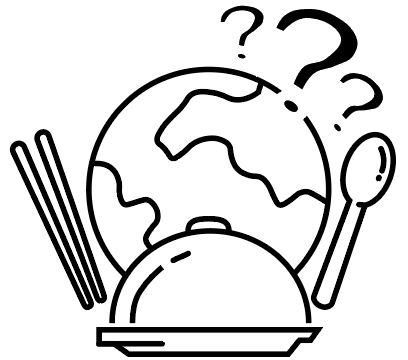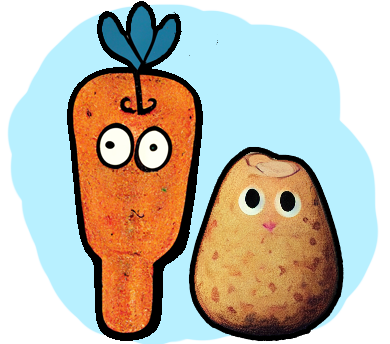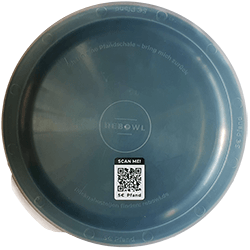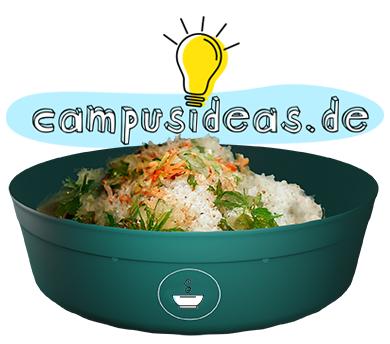On the bowl you will find a QR code for the deposit service. This is an active contribution to
Waste avoidance and thus environmental protection.
The deposit is currently 5 euros. The bowl is “microwave safe” and can also be stored in the fridge.
The question of what can be put on the plate occupies aid organizations and researchers worldwide. The HSRW students also got involved as part of the interdisciplinary seminar "Recipes for the campus and other disasters" thinking about an answer to this question.
The team tested recipes that were sustainable, nutritious, and contained ingredients that would be accepted by a majority of the world's population.
It should be checked and proven with scientific methods whether the selected recipes are basically edible for the entire world population. Due to this requirement, it was forbidden to use ingredients that are known to not be accepted everywhere for religious or cultural reasons. This includes almost every type of meat, milk and cheese variant, as well as spices or substances that can be harmful to health or even trigger allergies.

llustration by C. Skroch, 2022
Only ingredients from the 'Basic ingredients' and 'Fresh' categories are used in the scientific test tasting. The 'Spice' and 'Optional' areas are to be understood as an extension for everyday use and are not used for testing.
What are essential foods? Which ingredients are essential for life? Food is substances that the body needs to survive, but which it cannot produce itself. Human nutrition consists mainly of carbohydrates, proteins and fats. A finer distinction can be made in these categories, but the general rule is that the substances mentioned above must be present in the diet. In addition, a balanced diet must contain minerals and trace elements, as well as vitamins.
Our diet is basically made up as follows, with a daily energy requirement of around 2000 kcal:
| Minerals | does the body need for: | available in: | daily amount (approx.) adults |
|---|---|---|---|
| Fluor | Bones, Teeth | Black tea | 3,1- 3,8 mg |
| Iron | Nails, Teeth, Blood, Bones, skin | Poultry, egg, fish, wheat germ | 15 mg |
| Chrome | Blood, Circulatory System, Muscles | Corn Oil, Whole Wheat, Brewer's Yeast | 30–100 µg |
| Copper | Skin, Hair, Blood, Bones, Circulatory System | Nuts, Raisins Seafood, Soy | 1,0–1,5 mg |
| Calcium | Blood, Bones, Heart, Teeth, Skin | milk, almonds, cheese | 1000 mg |
| Potassium | Skin, Blood, Heart, Kidneys, Muscles, Nerves | Apricots, sunflower seeds, peaches, raisins, peanuts | 2000 mg |
| Iodine | Thyroid, Hair, Nails, Skin, Teeth | seafood, iodized salt | 200 µg |
| Sulfur | Skin, Connective Tissue, Mucous membrane, Thymus | Cheese, egg, nuts, fish | k. A. |
| Phosphorus | Bones, Brain, Nerves, Teeth | Egg, Milk, Poultry, Cheese | 700 mg |
| Sodium | Blood, Lymphatic System, Muscles, Nervous System | salt, milk, cheese, seafood | 550 mg |
| Manganese | Brain, Mammary Glands, Nervous System, Muscles | Bananas, Cereals, Lettuce, Nuts, Pineapple | 2–5 mg |
| Magnesium | Arteries, Bones, Heart, Muscles, Nerves, Teeth | green vegetables, honey, unshelled peanuts, spinach, seafood | 330 mg |
| Vitamins | available in: | daily amount (approx.) adults |
|---|---|---|
| Vitamin A (β-Carotin) | Egg yolk, liver, whole milk, spinach, red pepper | 1,0 mg |
| Vitamin B1 | Pork, Peas, Whole Grain | 1,2 mg |
| Vitamin B2 | Dairy products, cheese, meat, fish, broccoli | 1,3 mg |
| Vitamin B3 (Niacin) | liver, meat, egg, green leafy vegetables | 15 mg |
| Vitamin B5 (Pantothensäure) | liver, sunflower seeds, mushrooms | 6 mg |
| Vitamin B6 | Meat, milk, avocado, banana, potatoes, walnuts | 1,3 mg |
| Vitamin B7(Biotin) | Yeast, Liver, Egg Yolk, Lentils | 30-60 µg |
| Vitamin B9 (Folat) | Oranges, lettuce, cabbage, spinach, whole grains | 300 µg |
| Vitamin B12 | Meat, liver, egg, fish, dairy products | 3,0 µg |
| Vitamin C | Black currant, sea buckthorn, bell pepper, kale, broccoli, citrus | 115 mg |
| Vitamin D | Fatty fish such as eel and salmon | |
| Vitamin E (Tocopherol) | nuts, vegetable oils, butter, egg | 15 mg |
| Vitamin K | Spinach, cabbage, lettuce, watercress | 60 µg |
Data without guarantee. Compare Source: Deutsche Gesellschaft für Ernährung e. V. . Referenz: https://www.dge.de/wissenschaft/referenzwerte. Retrieved on 02. September 2022.
All recipes listed on this page can be varied for everyday preparation. Find out how here:
The question isn't party or partyey, or ketchup or ketchap. Rather, we would like to point out at this point that there are regional or seasonal restrictions on the range of fresh ingredients. A carrot, for example, can be replaced with any other root vegetable, the cooking time may vary.
Our recipes are variable and adaptable. This does not only apply in the event of a shortage of food. If the selection is large, you can of course add whatever your heart desires in everyday use. For the scientific study of the recipes, however, it was important to standardize basic ingredients in order to enable evaluation.

Potato, Potata. C. Skroch, 2022
Artichoke, eggplant, avocado (high fat content)
Bamboo shoots, celery (celery)
Cauliflower, green beans, bean sprouts, broccoli
Mushrooms, Chicory, Chinese Cabbage, Broad Beans
Iceberg lettuce, endive, peas
lamb's lettuce, fennel
Kale, Cucumbers
Celeriac, kohlrabi, lettuce, pumpkin, potatoes
leek
Swiss chard, carrots (carrots), corn
Peppers, chanterelle, pack choi
Radicchio, radish, radish, rhubarb, Brussels sprouts, red cabbage, beetroot
Sauerkraut, salsify, soybeans (high protein content)
Soybean sprouts, asparagus, spinach, porcini mushrooms
tomato
White cabbage, savoy cabbage
zucchini, onions
gherkins
Mixed pickles
tomato peppers
silver onions
Olives (high fat content)
The aim of our project is to develop and create a recipe book that is accepted by everyone - including students - from all over the world and that does justice to tastes. The recipe book is also to be published, so it has to appeal to a wide audience. It is intended to encourage people to try it again - even in the event of a disaster.
The associated interdisciplinary project is entitled "A recipe book for the campus and other catastrophes". The recipe suggestions should be simple so that they can be made without much effort even in the event of a disaster. For this purpose, a "cook box" with healthy and harmless basic ingredients was put together, which can be kept anywhere.
The problem and what distinguishes our recipe book from the others: There is no kitchen, no stove or a way to cool food in the event of a disaster, no electricity, no water.
But you all over the world need recipes that feed all people. The ingredients should be selected in such a way that they can be used by everyone, for example children, the elderly and people with disabilities. Of course, the food must not contain any poison, allergy-causing substances or other unhealthy additives.
A situation similar to the disaster scenario can also be found on a campus: no kitchens, no time to cook, many students from different countries, different religions and different tastes.
The dishes are created by students according to recipe specifications, first tested themselves, then audited according to quality standards in accordance with DIN EN ISO 9001: 2015 and then presented to an external jury. The jury consists of the expert director of the German Cookbook Museum in Dortmund, a representative of an aid organization specializing in foreign aid missions and a star TV chef. The aim is to obtain a statement on the general acceptance of the recipes that has been proven using scientific methods. That is the scientific claim of the project.

llustration by C. Skroch, 2022
The cook box contains the basic ingredients of the recipe collection, which can be kept for a relatively long time and can either be kept in stock or, in the event of a disaster, can be procured or delivered on site.
The selection of foods is available in Europe as well as in other parts of the world. The compilation can be supplemented individually. Of course, this applies to the quantities and quality of the products. Supermarket goods available from discounters were assumed here.
The products in the "Fresh" and "Optional" areas are not suitable for permanent storage. These ingredients may have to be fresh on site each day and processed quickly. But this selection should also be available worldwide or can simply be replaced by regional fresh produce.
Basic ingredients foods related to campusideas recipes:
1 glass noodle pack 100 g
1 rice: basmati & jasmine in a cooking bag 500 g
1 spaghetti package 500 g
1 bulgur pack 500 g
1 flour: spelled flour type 630 – pack 1000 g
1 oil: corn oil, bottle 750 ml
1 vegetable broth can 119g / 7 litres
1 durum or wheat wrap (vegetable) 800 g
3 cans of sweet corn of 140 g each
3 cans of chickpeas of 130 g each
3 cans of kidney beans of 125 g each
1 can of edamame soybeans 130 g
1 grind of sea salt (NaCl) 110 g
1 grinder of black pepper 50 g
“It has been said that civilization is twenty-four hours and two meals away from barbarism.”
Pratchett, Terry/Gaiman, Neil. Good Omens: The Nice and Accurate Prophecies of Agnes Nutter, Witch. 1990
Culture and civilization surround us as human beings like the air we breathe. The fulfillment of our basic needs is maintained by culture and civilization, only when some catastrophe befalls us do we even perceive what has held the world together at its core and that this aspect is now sorely missing. Diet plays a particularly important role in this. Because an empty stomach hurts. Civilization and culture and also a full stomach are mutually dependent and what happens when one factor fails is illustrated in a humorous way by the above quote from Terry Pratchett and Neil Gaiman.
If we, as 'normal' people, are already asking ourselves what is on the menu in times of scarcity and disaster, what about professional organizations that are supposed to help in such a case and, for example, deliver food to areas that are now, suddenly without the amenities of the time such. B. electricity etc. have to make do. Has anyone ever thought about it? Certainly. With this interdisciplinary project, we want to consider from the perspective of an aid organization what is necessary to ensure basic care for people in the event of a disaster. This also applies to the students on a campus.

Why bother. C. Skroch, 2022
Do you want to avoid rubbish? Do you want sustainable, reusable packaging? Then
REBOWL is just right for you!
A REBOWL is a plastic bowl with a lid in the deposit-return system that will be required by the EU for all restaurants with a take-away offer from 2023.

On the bowl you will find a QR code for the deposit service. This is an active contribution to
Waste avoidance and thus environmental protection.
The deposit is currently 5 euros. The bowl is “microwave safe” and can also be stored in the fridge.

llustration by C. Skroch, 2022
The plastic bowl is also suitable for dishwashers and, according to the manufacturer, can be used at temperatures of up to approx. 85 degrees Celsius. There are several size options at the deposit shops to choose from that are stackable. A list of the restaurants that offer REBOWL and also return the deposit can be found at
www.recup.de.
You can search for the 10,000 return deposit companies there using the keyword "Pfandnetz".
Link: recup.de/mehrwegschalen/